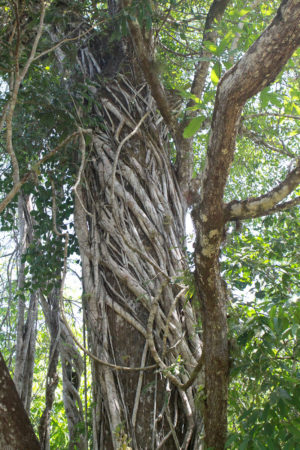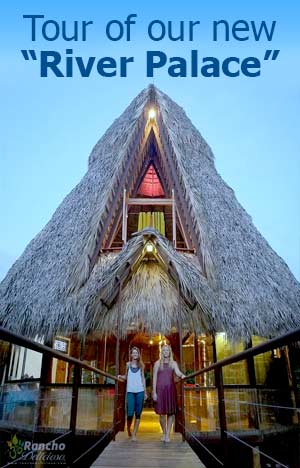Sustainable Forestry and Reforestation
Sustainable development requires wood, but at the same time we love trees, so finding a plan to sustainably plant and harvest trees is essential for an eco-village that’s attempting to be as self-sufficient as possible.
There are several issues to consider:
 Forestry Using Native Species
Forestry Using Native Species
It’s very popular to plant Teak and Melina trees in Costa Rica. Both are non-native species that are hated by conservationists but loved by the farmers who plant them. Hundreds of thousands, or perhaps millions of acres of forest have been cut down to plant monocultures of these trees, and you can see the farms of teak and melina everywhere here.
Planting of Foreign Species: Teak and Melina
Teak is terrible. Although it doesn’t spread to neighboring farms, it acidifies the soil around it, so almost nothing will grow in it, creating a biological desert. And the wood isn’t even very good. Only the dark heart/core of teak is bug-proof, so often people end up having to put poison on it to keep it termite free.
Melina is better for greenbuilding, although not as strong. It has natural bug repellents and we use it for sustainable construction because it’s cheap, available, and doesn’t need poisons for termite control. However, it’s an aggressive spreader because animals love its fruits. At this point it’s spread everywhere here and become part of the jungle, but for purists who want to work on developing a primary forest on their land using only native species, melina trees must be eliminated. Rancho Delicioso has them growing everywhere, and we’ve been cutting them down one by one to use the wood. We will replant with native species.
Habitat for Animals
Our plan is to reforest some areas of the farm in such a a way to create habitat for wild animals using only native hardwood trees.
In a wild jungle, most of the trees will be hardwoods, which usually grow far taller than the softer woods and live much longer. The softer trees are more likely to be found growing where larger trees have fallen over, or along rivers, so they should be less common. However, in an area like where we live in Costa Rica, where almost everything was cut down 80+ years ago, the soft wood trees heavily dominate. A native jungle should have a mix of hundreds of species, but a farm like ours has only a dozen or so types of trees, with a few unusual ones along rivers where they were never cut down. For the most part, every large tree with valuable hardwood has already been logged long ago, so the few large trees we have are species like Ceiba, Espavel, or Higueron (Banyan) which don’t have much commercial value.
What we will do is replant only the hardwood trees, using a backhoe to make a large soft hole, with a bag of manure and/or a wheelbarrow of compost. Then we’ll water and nurture them through their first few years until they can get well-established. The hardwood trees grow much more slowly, so we will need to make sure they aren’t overgrown with softer species like Balsa, which can easily out-compete them and take most of the available light. At the same time, the softwoods mixed in can help by giving partial shade, fixing nitrogen, bringing up minerals with their roots, and when cut down, provide lots of carbon (that they pulled out of the air from CO2) for the hardwoods to take advantage of. We must be careful to use the softwoods appropriately in such a way that eventually they will be mostly removed from the forest and the hardwoods will fully dominate.
The dream is that someday, our grandchildren or great-grandchildren will be able to selectively harvest these hardwood trees one by one, always replanting something to replace them, and consistently maintaining a healthy primary forest. To make this work, we will also add in many native species of Orchids and Bromiliads, which I have been rescuing and collecting for over a decade for this purpose.
Lists of Native Hardwoods for Reforestation
Fastest Growing Hardwoods
-
Various species grow at different rates. Some of these hardwoods grow faster than others and are exceptionally excellent for use in construction because of their strength and resistance to termites (especially the Cedro/Cedar trees.)
Cedro Amargo
Cedro Caoba
Cristobal/Caichimbo
Espavel Amarillo
Guanacaste
Pochote
Ron Ron
Slow Growing Hardwoods
-
Generally the harder the wood, the slower it grows. Some of these trees are so strong that a nail can’t be pounded into them. Others are so heavy they sink in water. The intention is to mix these slow-growing species into our new jungle, but NEVER cut them down for use in construction, since they are very rare (and some extinct) in the area.
Almendro de Montana
Caoba (Mahogany)
Cocobolo (Rosewood)
Coreza Negro
Guachipelin
Guayabon/Sura
Laurel
Madronia
Mora
Nazareno (Purple Heart)
Nispero
Ojoche
Roble
Species for Water Protection
-
These trees are planted and used by farmers to protect their springs. They have deep roots and are able to keep their leaves all year, never going into hibernation like many hardwoods do. The shade they provide keeps spring areas wetter and protects the water from evaporation so their animals can drink there.
Chilamate (Higueron/Fig/Banyan)
Zota Caballo
Espavel
Bamboo: An Alternative to Hardwoods
We currently have three species of construction-grade bamboos planted in three areas of the farm, with the intention to use them for building.
Bamboo grows faster and can be used in place of wood for many applications, and is amazing beautiful. It does need to be treated, and it has its downsides too, but our intention is to use bamboo in future construction once we have enough to start harvesting it, which will still be several more years. Best guess is that by 2025 we’ll have all the bamboo we need. Next will be the challenge of finding people who know how to build with it well. Carpenters here only know some basics with it, so we imagine that we’ll need to do a lot of training and experimentation starting in a few years in order to learn how to build the beautiful bamboo structures we are so inspired by on Instagram.














